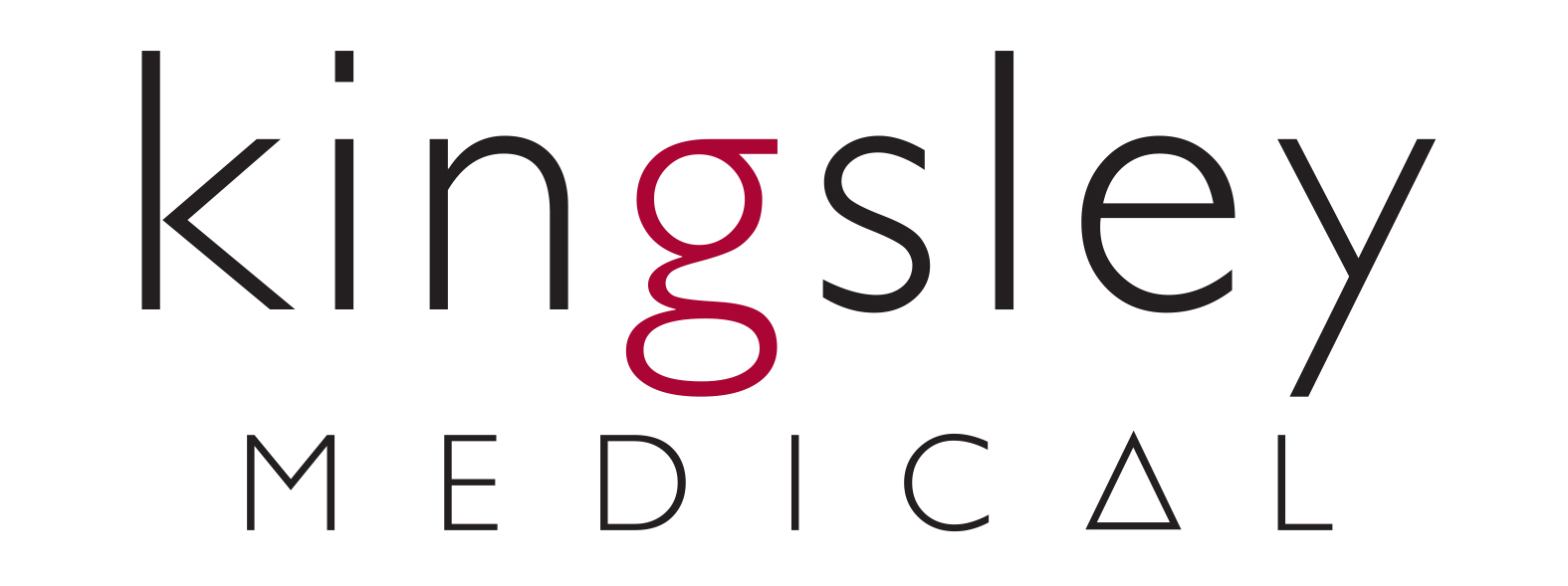Sub-acromial impingement
What is subacromial impingement?
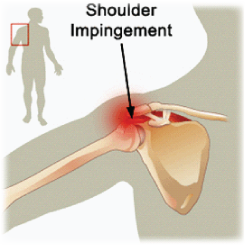 Sub-acromial impingement (SAI) encompasses any soft tissue inflammation that develops beneath the acromion – a ledge of bone at the top of the shoulder blade that connects with the collar bone to form the acromioclavicular (AC) joint. Generally, although not always, this is a result of mechanical irritation beneath the acromion (pictured below). Typically this includes sub-acromial bursitis, supraspinatus tendonopathy and, less commonly, the superior glenohumeral ligament or the long head of biceps tendon. The latter two of these present with quite unique clinical signs and, although they anatomically fit the definition of sub-acromial structures, they are assessed and treated quite differently. Not uncommonly SAI co-exists with acromio-clavicular joint arthropathies although again, the physiotherapy and medical management of this differs greatly to that of “typical” SAI and will not be discussed here.
Sub-acromial impingement (SAI) encompasses any soft tissue inflammation that develops beneath the acromion – a ledge of bone at the top of the shoulder blade that connects with the collar bone to form the acromioclavicular (AC) joint. Generally, although not always, this is a result of mechanical irritation beneath the acromion (pictured below). Typically this includes sub-acromial bursitis, supraspinatus tendonopathy and, less commonly, the superior glenohumeral ligament or the long head of biceps tendon. The latter two of these present with quite unique clinical signs and, although they anatomically fit the definition of sub-acromial structures, they are assessed and treated quite differently. Not uncommonly SAI co-exists with acromio-clavicular joint arthropathies although again, the physiotherapy and medical management of this differs greatly to that of “typical” SAI and will not be discussed here.
Causes of Sub-acromial impingement
Broadly, SAI is classified into one of 3 aetiological groups:
- Acute/Traumatic subacromial impingement arising from an isolated incident or traumatic event,
- Overuse/repetitive strain. This may be the sort of overuse injury seen in the shoulders of swimmers or with unaccustomed use that extend the patient’s regular activities .
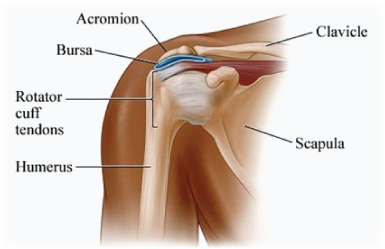 Spontaneous/age related irritation or rupture of the supraspinatus tendon. This type of injury more commonly affects individuals over the age of 60 and can result in complete upturing of the supraspinatus tendon or other tendons of the rotator cuff. Septic bursitis/tendonitis (often iatrogenic) is potentially a fourth aetiological grouping but is far less commonly seen and is managed medically rather than with physiotherapy.
Spontaneous/age related irritation or rupture of the supraspinatus tendon. This type of injury more commonly affects individuals over the age of 60 and can result in complete upturing of the supraspinatus tendon or other tendons of the rotator cuff. Septic bursitis/tendonitis (often iatrogenic) is potentially a fourth aetiological grouping but is far less commonly seen and is managed medically rather than with physiotherapy.
Most frequently, the aggravating activity will involve sustained or repetitive positioning of the shoulder above 90o abduction and/or above 150o flexion. The shoulder is vulnerable in extension though this is rarely a movement utilised repetitively during normal daily activity. Forced extension (as seen in contact sports) is far more likely to result in acromio-clavicular or capsular damage (anterior dislocations) than in SAI.
Radiographic Imaging of sub-acromial impingement
In all cases of SAI several predisposing anomalies must be considered, especially if patients do not obtain dramatic improvements (60% to 70% at least) after 2 or 3 treatments. X-rays can be very helpful to rule out or confirm the presence of bony spurs (opposite). Most commonly these are found on the lateral margin of the acromion and are seen on axillary views of the shoulder. Less commonly, spurs on the greater tubercle can mimic SAI 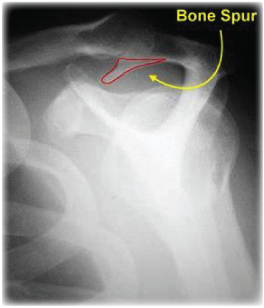 symptoms and these are best observed on AP views.
symptoms and these are best observed on AP views.
X-rays are also helpful to observe excessive curvature of the acromion (graded I, II and III) or superior positioning of the humeral head (often the result of previous injury or glenohumeral degeneration) – both anomalies lead to a reduced sub-acromial space and a much greater chance of tissue impingement. Less frequently previous tendon injuries will result in calcification of tendons (or calcific deposits) and when this occurs in the supraspinatus tendon, SAI frequently ensues.
In individuals with SAI over the age of 55 that are not responding to physiotherapy very rapidly, an ultrasound image of the shoulder (together with an x-ray) can be useful to determine the extent of tendon damage and whether or not it is worth pursuing physiotherapy as a cost effective means of treatment – incomplete tendon tears of the supraspinatus at its insertion on the humerus are much more difficult and costly to treat (6 to 8 sessions) than partial tears proximal to the last 10mm of the tendon (approximately 2 to 4 sessions).
Physical Assessment
As always, a sound history must be taken from the patient. This includes causative events, painful stimuli and a detailed description of the discomfort and limitation they are experiencing. Generally, SAI patients will describe a causative event (as outlined above) or a more gradual onset of symptoms over several days. Pain may be described as “catching”, “aching” or even “heaviness” around the lateral acromion and often extending into the lateral deltoid to the mid brachium. For patients that have had symptoms for more than 1 to 2 weeks, pain will often radiate as far down as the elbow with certain movements and may also give rise to a muscular pain (also described as a ‘burning’ sensation) around the rhomboids and superior angle of the scapula.
The patient’s shoulder movements are then assessed. This includes assessment of the sterno-clavicular and scapulothoracic ‘joints’. It is then a matter of proceeding through the numerous orthopaedic tests for rotator cuff, bicep, tricep, labral, capsular and cervical soft tissues that may also be involved. Much like nerve irritation in the lumbar spine is assessed by performing a straight-leg-raise, slump test or prone-knee-bend, the physiotherapist will also assess the nerves of the brachial plexus and bias the three main nerves of the upper limb (radial, ulna and median) to determine their involvement. It is worth noting that although secondary neural involvement is rare in SAI, it is a remarkably common finding in cases of lateral or medial epicondylitis (tennis elbow and golfers elbow) that have persisted beyond 8 weeks.
It is a misconception that rotation (especially internal) of the shoulder is always affected in SAI or rotator cuff pathology. Although it is important to assess rotatory movements in neutral, 90o flexion and 90o abduction, these are not always limited and if they are, they are not diagnostic of any single pathology but instead should be used to add to the picture rather than complete it.
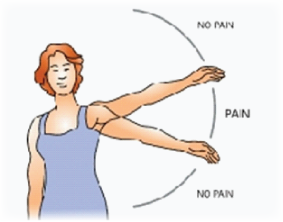 Thorough palpation adds to the picture and helps to rule out the involvement of structures such as the coracoid bursa, cervical rib and AC joint. It is important to note that not all presentations of SAI (either SS tendonopathy or subacromial bursitis) will show the classic “impingement” signs. Neer’s, Hawkins, drop-test, painful-arc testing etc are frequently negative, especially when there is associated co-pathology of the joint. Infraspinatus tendonopathy, labral damage or cervical involvement also regularly cloud the classic ‘impingement’ presentation.
Thorough palpation adds to the picture and helps to rule out the involvement of structures such as the coracoid bursa, cervical rib and AC joint. It is important to note that not all presentations of SAI (either SS tendonopathy or subacromial bursitis) will show the classic “impingement” signs. Neer’s, Hawkins, drop-test, painful-arc testing etc are frequently negative, especially when there is associated co-pathology of the joint. Infraspinatus tendonopathy, labral damage or cervical involvement also regularly cloud the classic ‘impingement’ presentation.
Physiotherapy treatment of sub-acromial impingement
Once a diagnosis has been made (and perhaps more importantly, other co-existing pathologies have been ruled out), the treatment of SAI is quite straight forward. Those patients that present with the classic ‘painful-arc’ of movement are by far the easiest to treat and results should be fairly immediate with any presentation of SAI.
Firstly, the posterior shoulder musculature is released (upper trapezius, levator scapulae, infraspinatus/teres minor and especially the rhomboids). This is not a particularly comfortable treatment and frequently leaves the patient feeling bruised for a day or so.
The physiotherapist will then mobilise (loosen) the glenohumeral or (more commonly) the AC joint. In stubborn or chronic cases, the pectorals and biceps are also released and the patients shoulder is taped (much like AFL players have their shoulders taped).
On subsequent consults (usually only 2 or 3 are required to fully resolve the pain and limitation in range), the muscle release work is repeated and more aggressive loosening of the glenohumeral joint is added. This may involve traction of the joint.
Finally, once pain free shoulder range above 150o flexion and abduction is achieved, the patient is then discharged with a strengthening programme – either a progressive rotator cuff routine (which strengthens and facilitates the normal contraction of the rotator cuff muscles throughout range) and/or a scapular stabilisation programme. The ways in which these programmes can be performed is as varied as the individual therapists prescribing the routine and as a rule, the therapist who has the most stimulating (mentally) and least time consuming programme will invariably achieve the greatest compliance and best results for their patients.
It is unfortunate that many in the medical profession (physiotherapists included) shy away from treating shoulders aggressively and handball them directly to orthopaedic surgeons. The irony is that treating such patients post-operatively is usually much harder than it is to manage them in order to avoid the surgeon’s knife.
If you have any further questions on this subject, or you would like to contact the physiotherapist best suited to managing your problem please call or email us.
© Andrew Thompson



